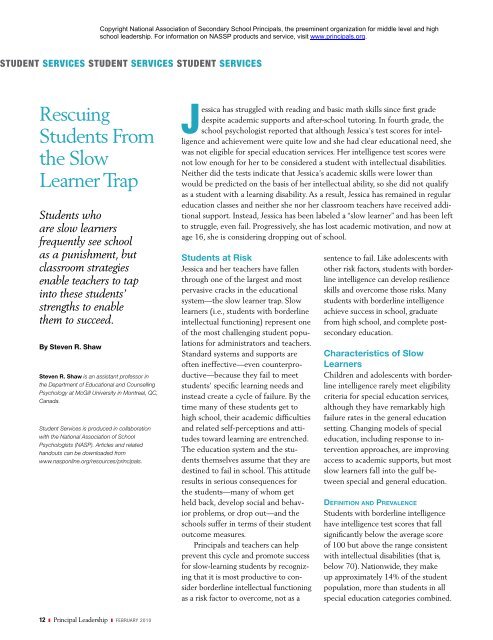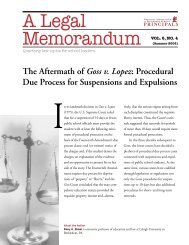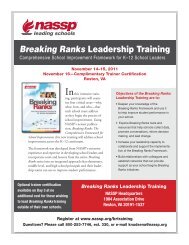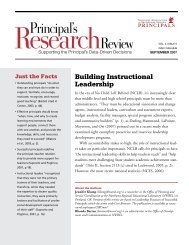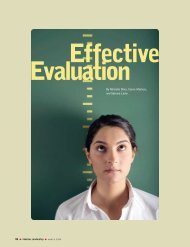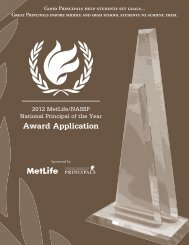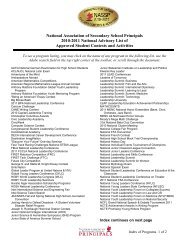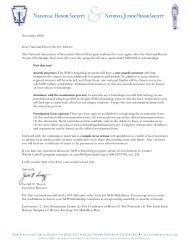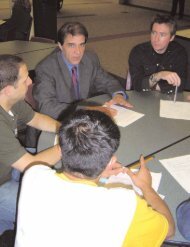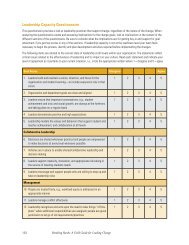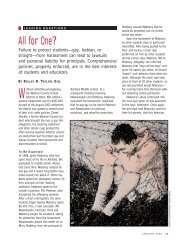Rescuing Students From the Slow Learner Trap - National ...
Rescuing Students From the Slow Learner Trap - National ...
Rescuing Students From the Slow Learner Trap - National ...
Create successful ePaper yourself
Turn your PDF publications into a flip-book with our unique Google optimized e-Paper software.
student services student services student services<strong>Rescuing</strong><strong>Students</strong> <strong>From</strong><strong>the</strong> <strong>Slow</strong><strong>Learner</strong> <strong>Trap</strong><strong>Students</strong> whoare slow learnersfrequently see schoolas a punishment, butclassroom strategiesenable teachers to tapinto <strong>the</strong>se students’strengths to enable<strong>the</strong>m to succeed.By Steven R. ShawSteven R. Shaw is an assistant professor in<strong>the</strong> Department of Educational and CounsellingPsychology at McGill University in Montreal, QC,Canada.Student Services is produced in collaborationwith <strong>the</strong> <strong>National</strong> Association of SchoolPsychologists (NASP). Articles and relatedhandouts can be downloaded fromwww.nasponline.org/resources/principals.Jessica has struggled with reading and basic math skills since first gradedespite academic supports and after-school tutoring. In fourth grade, <strong>the</strong>school psychologist reported that although Jessica’s test scores for intelligenceand achievement were quite low and she had clear educational need, shewas not eligible for special education services. Her intelligence test scores werenot low enough for her to be considered a student with intellectual disabilities.Nei<strong>the</strong>r did <strong>the</strong> tests indicate that Jessica’s academic skills were lower thanwould be predicted on <strong>the</strong> basis of her intellectual ability, so she did not qualifyas a student with a learning disability. As a result, Jessica has remained in regulareducation classes and nei<strong>the</strong>r she nor her classroom teachers have received additionalsupport. Instead, Jessica has been labeled a “slow learner” and has been leftto struggle, even fail. Progressively, she has lost academic motivation, and now atage 16, she is considering dropping out of school.<strong>Students</strong> at RiskJessica and her teachers have fallenthrough one of <strong>the</strong> largest and mostpervasive cracks in <strong>the</strong> educationalsystem—<strong>the</strong> slow learner trap. <strong>Slow</strong>learners (i.e., students with borderlineintellectual functioning) represent oneof <strong>the</strong> most challenging student populationsfor administrators and teachers.Standard systems and supports areoften ineffective—even counterproductive—because<strong>the</strong>y fail to meetstudents’ specific learning needs andinstead create a cycle of failure. By <strong>the</strong>time many of <strong>the</strong>se students get tohigh school, <strong>the</strong>ir academic difficultiesand related self-perceptions and attitudestoward learning are entrenched.The education system and <strong>the</strong> students<strong>the</strong>mselves assume that <strong>the</strong>y aredestined to fail in school. This attituderesults in serious consequences for<strong>the</strong> students—many of whom ge<strong>the</strong>ld back, develop social and behaviorproblems, or drop out—and <strong>the</strong>schools suffer in terms of <strong>the</strong>ir studentoutcome measures.Principals and teachers can helpprevent this cycle and promote successfor slow-learning students by recognizingthat it is most productive to considerborderline intellectual functioningas a risk factor to overcome, not as asentence to fail. Like adolescents witho<strong>the</strong>r risk factors, students with borderlineintelligence can develop resilienceskills and overcome those risks. Manystudents with borderline intelligenceachieve success in school, graduatefrom high school, and complete postsecondaryeducation.Characteristics of <strong>Slow</strong><strong>Learner</strong>sChildren and adolescents with borderlineintelligence rarely meet eligibilitycriteria for special education services,although <strong>the</strong>y have remarkably highfailure rates in <strong>the</strong> general educationsetting. Changing models of specialeducation, including response to interventionapproaches, are improvingaccess to academic supports, but mostslow learners fall into <strong>the</strong> gulf betweenspecial and general education.Definition and Prevalence<strong>Students</strong> with borderline intelligencehave intelligence test scores that fallsignificantly below <strong>the</strong> average scoreof 100 but above <strong>the</strong> range consistentwith intellectual disabilities (that is,below 70). Nationwide, <strong>the</strong>y makeup approximately 14% of <strong>the</strong> studentpopulation, more than students in allspecial education categories combined.12 z Principal Leadership z february 2010
They account for disproportionatelyhigh proportions of <strong>the</strong> students whodrop out of school, are retained, arereferred for special education, becomepregnant, are incarcerated, use drugs,exhibit aggression and o<strong>the</strong>r mentalhealth problems, and are underemployedor unemployed. Moreover,<strong>the</strong> failure rates for slow learners arerising as tolerance for social promotiondecreases and passing standardizedhigh-stakes tests is required for gradepromotion and graduation.Learning Characteristics<strong>Slow</strong> learners have several characteristicsthat make classroom instructionchallenging:n They perform at a higher levelwhen information is presentedin a concrete fashion. Themore abstract a concept orteaching technique, <strong>the</strong> moredifficult it is for <strong>the</strong>m to learn.n They do not transfer or generalizeskills, knowledge, andstrategies as well as <strong>the</strong>ir sameagepeers. They tend to learnwhat is taught quite well buthave difficulty transferring andapplying <strong>the</strong> concepts taughtto new situations.n They have difficulty cognitivelyorganizing new material andassimilating incoming informationinto previously acquiredinformation.n They have difficulty withlong-term goals and timemanagement.n They benefit from increasedacademically engaged time.They often require extrapractice and more time on taskto develop <strong>the</strong> same level ofacademic skills as <strong>the</strong>ir typicallydeveloping peers.n They nearly always developacademic motivation deficits.Issues for Secondary SchoolsWhen students who are slow learnersmove on to secondary school, <strong>the</strong>ir academicand social issues often becomemore severe and difficult to change.Moreover, organizational challengesin secondary schools present barriersto supporting this large population ofat-risk students.Secondary schools can be alienatingenvironments for many students.A single teacher is no longer fullyresponsible for each student’s successor failure. In secondary school, eachteacher often sees 150 or more differentstudents in <strong>the</strong> course of a week.Opportunities for close relationshipsbetween teachers and students arelimited. For slow learners, having closerelationships with educators and mentorsis necessary for <strong>the</strong>m to overcomeacademic motivation deficits and selfconceptissues and to continue to developstudy skills. In addition, studentswho are slow learners are at higherrisk for behavior and mental healthproblems. A strong and cohesive adultsupport system at school is a requirementfor slow learners’ academic andsocial success.Although <strong>the</strong>re are multiple reasonsthat slow learners rarely graduatefrom high school, two systemic barriersto graduation stand out. First, moststates and provinces require studentsto complete an algebra class to graduate.Algebra requires generalization oflearned knowledge to new problems.The abstract nature of algebra and <strong>the</strong>requirement to generalize knowledgedirectly target <strong>the</strong> academic weaknessesof slow learners.The second barrier is many of <strong>the</strong>tests that are required for graduation.Secondary schools can bealienating environmentsfor many students.A single teacher is nolonger fully responsiblefor each student’ssuccess or failure.february 2010 z Principal Leadership z 13


